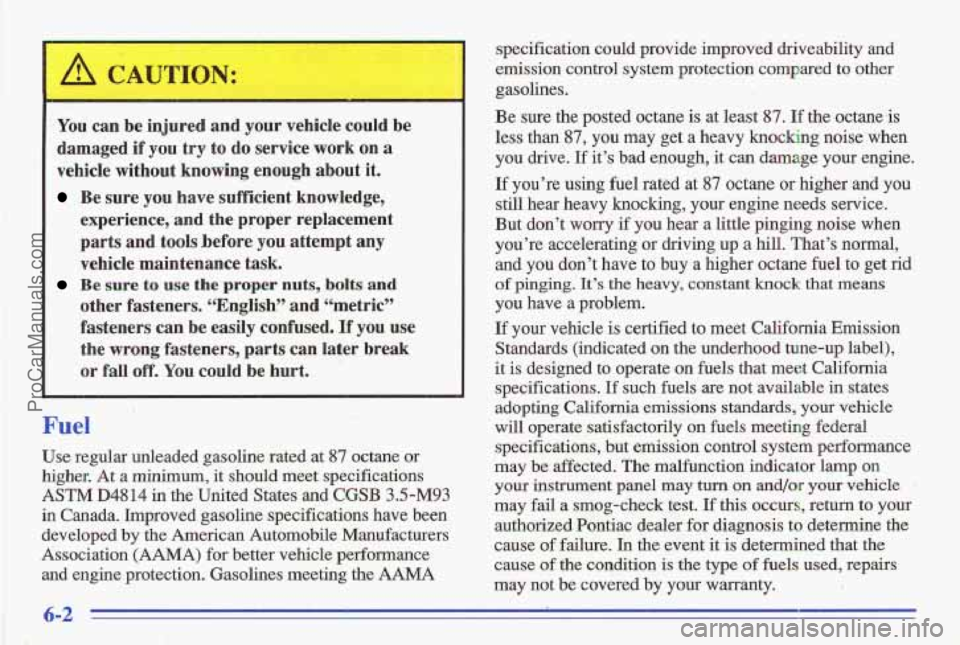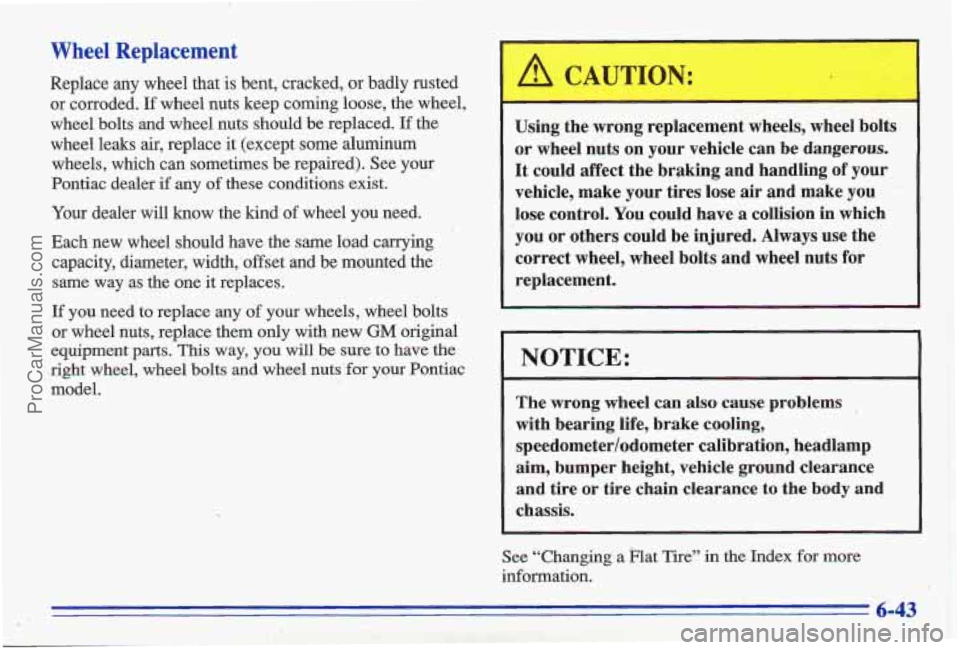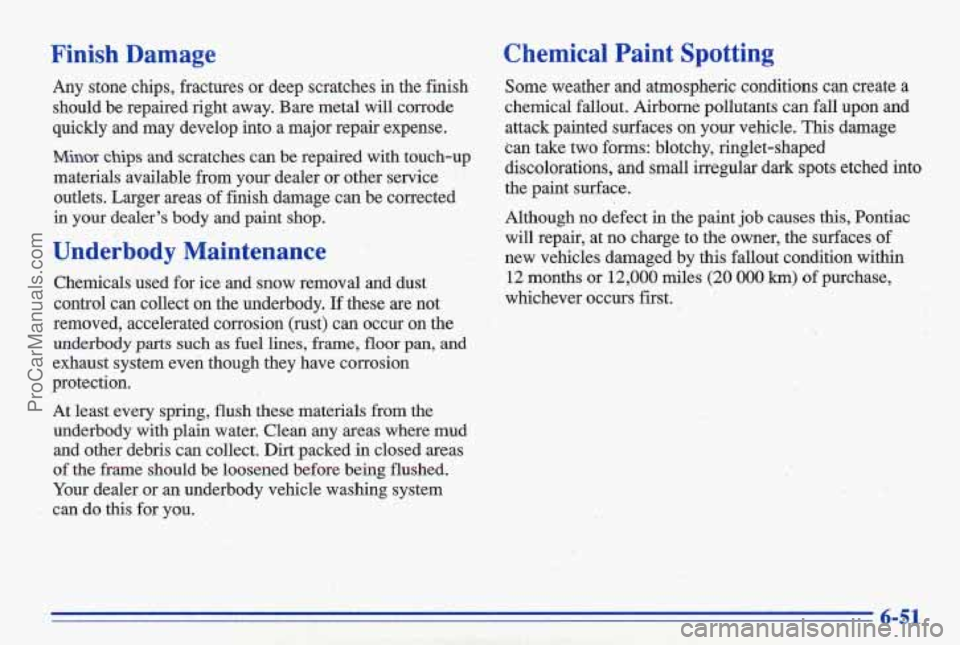1996 PONTIAC GRAND-AM air condition
[x] Cancel search: air conditionPage 224 of 356

A CAUTION:
You can be injured and your vehicle could be
damaged if you try to do service work on a
vehicle without knowing enough about it.
Be sure you have sufficient knowledge,
experience, and the proper replacement
parts and tools before you attempt any
vehicle maintenance task.
Be sure to use the proper nuts, bolts and
other fasteners. “English” and “metric”
fasteners can be easily confused. If
you use
the wrong fasteners, parts can later break
or fall off. You could be hurt.
,, ~
Fuel
Use regular unleaded gasoline rated at 87 octane or
higher.
At a minimum, it should meet specifications
ASTM D4814 in the United States and CGSB 3.5-M93
in Canada. Improved gasoline specifications have been
developed by the American Automobile Manufacturers
Association
(AAMA) for better vehicle performance
and engine protection. Gasolines meeting the AAMA specification could provide improved driveability and
emission control system protection compared to other
gasolines.
Be ,sure the posted octane
is at least 87. If the octane-is
less
than 87, you may get a heavy knocking noise when
you drive. If it’s bad enough, it can damage your engine.
If you’re using fuel rated at 87 octane or higher and you
still hear heavy knocking, your’engine needs service.
But don’t worry if you hear a little pinging noise when
you’re accelerating
or driving up a hill. That’s normal,
and you don’t have to buy a higher octane fuel to get rid
of pinging. It’s the heavy, constant knock that means
you have a problem.
If your vehicle is certified to meet California Emission
Standards (indicated on
the underhood tune-up label),
it is designed to operate
on fuels that meet California
specifications. If such fuels
are not available in states
adopting California
emissions standards, your vehicle
will operate satisfactorily
on fuels meeting federal
specifications, but emission control system performance
may be affected. The malfunction indicator lamp
on
you instrument panel may turn on and/or your vehicle
may fail a smog-check test.
If this occurs, return to your
authorized Pontiac dealer for diagnosis to determine the
cause of failure.
In the event it is determined that the
cause
sf the condition is the type of fuels used, repairs
may not be covered
by your warranty.
ProCarManuals.com
Page 253 of 356

NOTICE:
I I
Continuing to drive with worn-out brake pads
could result in costly brake repair.
Some driving conditions or climates may cause a brake
squeal when the brakes
are first applied or lightly
applied. This does not mean something
is wrong with
your brakes.
Free movement
of brake calipers and properly torqued
wheel nuts are necessary to help prevent brake
pulsation. When tires are rotated, inspect brake calipers
for movement, brake pads for wear, and evenly torque
wheel nuts in the proper sequence to
GM specifications.
Your rear drum brakes don't have wear indicators, but
if
you ever hear a rear brake rubbing noise, have the rear
brake linings inspected.
Also, the rear brake drums
should be removed and inspected each time the tires
are
removed for rotation or changing. When you have the
front brakes replaced, have the rear brakes inspected, too.
Brake linings should always be replaced as complete
Brake Pedal Travel
See your dealer if the brake pedal does not return to
normal height, or if there is a rapid increase in pedal
travel. This could be a sign
of brake trouble.
Brake Adjustment
Every time you make a moderate brake stop, your disc
brakes adjust for wear.
If you rarely make a moderate ar
heavier stop, then your brakes might not adjust correctly.
If you drive in that way, then -- very carefully -- make
a few moderate brake stops about every 1,000 miles
(1 600 km), so your brakes will adjust properly.
If your brake pedal goes down farther than normal, your
rear drum brakes may need adjustment. Adjust them by
backing up
'and firmly applying the brakes a few times.
Replacing Brake System Parts
The braking system on a modem vehicle is complex. Its
many parts have to be
of top quality and work well
together
if the vehicle is to have really good braking.
Vehicles we design and teSt have top-quality
GM brake
parts in them,
as your Pontiac does when it is new.
When you replace parts
of your 'braking system -- for
example, when your brake linings wear down and you
have to have new
ones put in -- be sure you get new
genuine
GM replacement parts. If you don't, your
6-31
ProCarManuals.com
Page 265 of 356

Wheel Replacement
Replace any wheel that is bent, cracked, or badly rusted
or co’rroded.
If wheel nuts keep coming loose, the wheel,
wheel bolts and wheel nuts should be replaced.
If the
wheel leaks air, replace it (except some aluminum
wheels, which can sometimes be repaired). See your
Pontiac dealer if any
of these conditions exist.
Your dealer will know the kind
of wheel you need.
Each new wheel should have the she load carrying
capacity, diameter, width, offset and be mounted the
same way as the one it replaces.
If you need to replace any of your wheels, wheel bolts
or wheel nuts, replace them only with new
GM original
equipment
parts. This way, you will be sure to have the
right wheel, wheel bolts
and wheel nuts for your Pontiac
model.
A CAUTION:
Using the wrong replacement wheels, wheel bolts
or wheel nuts on your vehicle can be dangerous.
It could affect the braking and handling
of your
vehicle, make your tires lose air and make you
lose control. You could have
a collision in which
you
or others could be injured. Always use the
correct wheel, wheel bolts and wheel nuts
for
replacement.
NOTICE:
The wrong wheel can also cause problems
with bearing life, brake cooling,
speedometer/odometer calibration, headlamp
aim, bumper height, vehicle grou.nd clearance
and tire
or tire chain clearance to the body and
chassis.
See “Changing a plat Tire” in the Index for more
information.
6-43
ProCarManuals.com
Page 273 of 356

Finish Damage
Any stone chips, fractures or deep scratches in the finish
should be repaired.right away. Bare metal will corrode
quickly and may develop i-nto a major repairexpense.
Minor chips and scratches can be repaired with touch-up
materials available from your dealer or other service outlets. Larger areas of finish damage can be correcte'd
in your dealer's body and paint shop.
,Underbody Maintenance
Chemicals used for ice and snow removal and dust
control
can collect on the underbody. If these are not
removed, accelerated corrosion (rust) can occur on the
underbody parts such as fuel lines,-frame, floor pan, and
exhaust system even though they have corrosion
protection.
At least every spring, flush these materials from the underbody with plain water. Clean any areas where mud and other debris can collect.
Dirt packed in closed areas
of
the frame should be loosened before being flushed.
Your dealer or
an underbody vehicle washing system.
can do this for you.
Chemical Paint Spotting
Some weather and atmospheric conditions can create a
chemical fallout. Airborne pollutants can fall upon and
attack painted surfaces on your vehicle. This damage
%an take two forms: blotchy, ringlet-shaped
discolorations, and small irregular dark spots etched into
the paint surface.
Although no defect in the paint job causes this, Pontiac
will repair, at
no charge to the owner, the surfaces of
new vehicles damaged by this fallout condition within
12 months or 12,000 miles (20 000 km) of purchase,
whichever occurs first.
6-51
ProCarManuals.com
Page 278 of 356

Fuse
INT LPS
PWR
ST
RDO IGN
HTR-A/C
CRUISE
TAIL LPS
a Fuse Useage
PWR WDO Power Window (Circuit Breaker)
TURN Turn Signal Lamps
Useage
Alarm Module (Illuminated Entry,
Warning Chimes, Overhead
Lamps., MapJReading Lamps,
Glove Box Lamp, Trunk Lamp,
Radio, Power Mirrors), Anti-Lock
Brakes, Variable
Effort Steering,
Remote Keyless
Entry
Power Seat ?,,,. :. . . .- . - . .. .. Radi&-<-'&'.: ?.>I' ?;~-,~:-~~~,(l ,;,* , ' _. . . I' . &-:.*& . : ' . . I 8.. .~ . . .I d&
Heater/Air Conditioning Blower,
Daytime Running Lamps, Automatic Light Control
Cruise Control
Parking Lamps, Taillamps,
Sidemarker Lamps, License
Lamps, Instrument Panel Lights,
Headlamp
Warning Alarm
Cigarette Lighter
6-56
ProCarManuals.com
Page 280 of 356

Engine Compartment Fuse Block Fuse
F/P INJ
ERLS
ABs/Evo
IGN MOD
HVAC
BLO MOT
PCM BATT
CLG FAN
HDLP
STOP LPS
PWR ACC
RR DEFG
ABS
Usage
Fuel Pump: Fuel Injectors
Back-up
Lamps: Canister Purge Valve,
EGR: Automatic Transmission,
Brake Transmission Shift Interlock,
Anti-lock Brakes: Variable
Effort
Steering, Air Conditioning
Compressor,
Park Lock Solenoid
Anti-Lock Brake Solenoids,
Variable Effort Steering
Ignition System
Heater/Ais Conditioner-High Blower, Generator-Voltage Sense
Powertrain Computer
Engine Cooling Fan
Lighting Circuits
Power Accessories,
Stop Lamp Circuits,
Rear Window Defogger
Anti-Lock Brakes,
Variable
Effort Steering
Ignition Switched Circuits
I , ^*^ >, .. ,.",
The engine compartment fuse block is located on the
driver's side
of the engine compartment, near the battery,
€GN sw
ProCarManuals.com
Page 282 of 356

Capacities and Specifications
Engine Crankcase
2.4LEngine ...........................................
3.1LEngine ...........................................
Pan Removal and Replacement ............................
After Complete Overhaul ................................
Automatic Transaxle
When draining or replacing torque converter, more fluid may be needed.
Manual mansaxle
Complete Drain and,Refill ...............................
Cooling System
2.4LEngine ............................................
3.1LEngine ............................................
Refrigerant, Air Conditioning
See refrigerant charge label und'er hood.
FuelTank .............................................
Tire Pressures, Sizes ....................................
4.0 quarts (3.8 L)
4.5 quarts (4.3 L)
6.0 quarts (5.7 L)
8.0 quarts (7.6 L)
2.0 quarts (1.9 L)
11.3 quarts (10.7 L)
13.6 quarts (12.9 L)
15.2 gallons (57.5 L)
See Tire-Loading Information
label
on driver's door.
100 lb-ft (140 N-m) WheeINutTorque ......................................
Windshield Wiper Blade (Pin Type)
Length ............................................... 19 inches (48 cm)
PartNumber
.......................................... 22155381
Note:
All capacities are approximate. When adding, be sure to fill to the appropriate level or as recommended in this manual.
6-60
ProCarManuals.com
Page 284 of 356

. ’ Normal Maintenance Replacement Parts
Air Cleaner Element
2.4L ............... AC me A-1233.C
3.1L ................ AC Type A-1233C
Engine Oil Filter
2.4L ............... AC Type PF-44
3.1L ............... AC Type PF-47
Spark Plugs
2.4L ............... AC Type 041-910, .
3.1L ............... AC Type 41-9110,
Gap: 0.060 inch (1.52 mm)
Gap: 0.060 inch (1.52 mm)
Air Conditioning Refrigerants..
Not all air conditioning refrigerants are the same.
If the air conditioning system in your vehicle needs
refrigerant,
be sure the proper refrigerant is used.
If you’re not sure, ask your Pontiac dealer.
: .
6-62
ProCarManuals.com